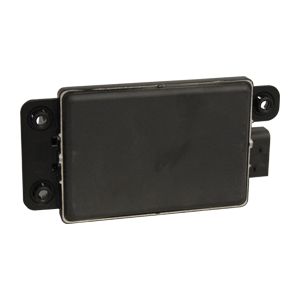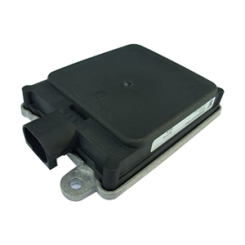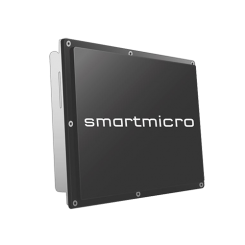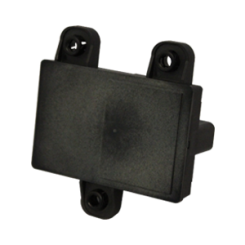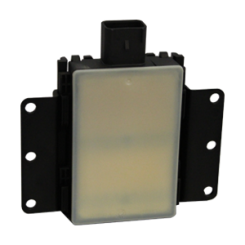Aptiv ESR 2.5
Aptiv’s multimode Electronically Scanning RADAR (ESR) combines a wide field of view at midrange with long-range coverage to provide two measurement modes simultaneously. While earlier forward-looking radar systems used multiple beam radars with mechanical scanning or several fixed, overlapping beams to attain the view required for systems like adaptive cruise control, Aptiv’s multimode ESR provides wide coverage at mid-range and high-resolution long-range coverage using a single radar. Wide, mid-range coverage not only allows vehicles cutting in from adjacent lanes to be detected but also identifies vehicles and pedestrians across the width of the equipped vehicle. Long-range coverage provides accurate range and speed data with powerful object discrimination that can identify up to 64 targets in the vehicle’s path.
Aptiv’s technologically advanced ESR uses proven solid-state technology plus class-leading performance, packaging and durability to offer customers game-changing forward radar detection. The quality of data provided by Aptiv’s system enables powerful functionality including adaptive cruise control, forward collision warning, brake support and headway alert.
ROS driver for CAN interface available, ethernet coming soon
Fully supported by your AStuff team
IP address specified on request with the sale of a unit
Features
- 24VDC for Commercial Applications
- Integrated 3-Axes Accelerometer
- Multi-mode, multi-application capability
- Simultaneous long- and mid-range functionality
- Solid-state Technology, no moving parts
- Extremely reliable Class-leading performance and durability
- Resistant to vibration and extremely robust
- Dual-mode classification enhances object reliability
- Simultaneous Transmit and Receive Pulse Doppler
- Compact packaging
- Complete radar module, including electronics, measures just 1178.3mm x 91.3mm x 40.8mm including mounting features
- Produced using processes proven in high-volume manufacture of engine control units
- Horizontal Field of View
- Mid-Range (60m): ± 45 deg
- Long-Range (174m): ± 10 deg
Electronically scanning radar (ESR) enables the following features:
- Adaptive Cruise Control with Stop & Go
- Enhances driver convenience
- Reduces driver workload
- Forward Collision Warning
- Helps reduce the potential for an accident and injury
- Helps reduce the potential for property damage
- Brake Support
- Helps reduce the potential for an accident and injury
- Helps reduce the potential for property damage
- Headway Alert
- Provides distance information
- Alerts driver when the preset time-gap to a vehicle ahead is violated
Media

FAQs
- Can multiple ESR sensors be on the same CAN network? Can I change the CAN ID?
Answer
No, CAN ID’s are fixed and cannot be changed. Similarly, multiple ESRs cannot be on the same private CAN bus since the ESRs use the same IDs. Furthermore, 120Ω CAN terminators present on the Private CAN also prevent the use of multiple ESRs on the same private CAN bus. - What is the default IP address for the ESR 2.5? Can I change this?
Answer:
The default IP address for the Ethernet connection on the ESR 2.5 is 169.254.145.71. This cannot be changed. If you require a specific IP address, Aptiv can make the requested configuration. - Are there any settings or thresholds that might increase the maximum detection range?
Answer:
No. The sensitivity thresholds are set by unit-specific calibrations to avoid false targets from internal noise. The sensitivity has been optimized for pedestrian detection. - The track width of any Track ID is always zero or not reported. Is this a malfunction?
Answer:
The ESR does not calculate track width even though a signal exists for it. This signal is a placeholder. - The acceleration of the detected object is always zero or -25.6 m/s2, even when there is a pedestrian running in front of the RADAR. Is this a malfunction?
Answer:
No. Only the lateral rate for moving targets with low ground speed (>7.5m/s) is calculated and is zero most of the time. The calculated lateral rate is used to improve the tracking of sharply turning targets for automotive applications. - How are range_Rate and lateral_Rate calculated?
Answer:
Range rate is that radial velocity. Use Equation I to convert from radial velocity to longitudinal velocity, Where Shost is the host speed ṙ is the target range rate, and θ is the target angle. The reported lateral rate is calculated the Aptiv tracker. Depending on which software version is used, the lateral rate may be zero most of the time. The lateral rate is a filtered version of the lateral position (calculated from the target range and target angle). Note, the range and angle rate from the radar are radial, and, therefore, the lateral rate is also radial.

- Why is it advised to mount the Aptiv ESR at least 35cm above street level?
Answer:
If the ESR is mounted too low, then it cannot illuminate vehicle targets at very close ranges given its narrow
vertical beam width. (i.e. the RADAR will look underneath intended vehicle targets). - At each scan (i.e. 50ms) does the RADAR return the updated position of each active track?
Answer:
Yes. The RADAR updates all tracks every 50ms. This allows access to all track points in real time, assuming there are detections for that track. - What is the expected detection range of the ESR with actual humans?
Answer:
For a pedestrian (modeled as a -10dBsm corner reflector) within the medium-range field of view, the maximum
range is approximately 40m. For a pedestrian within the long-range field of view, the maximum range is
approximately 55m. - Raw data from the RADAR contains 64 objects whose information is stored in IDs 0x500 – 0x5CF. Are these unsorted?
Answer:
Yes. It is not possible for the user to predict which track ID any object will get sorted into.

